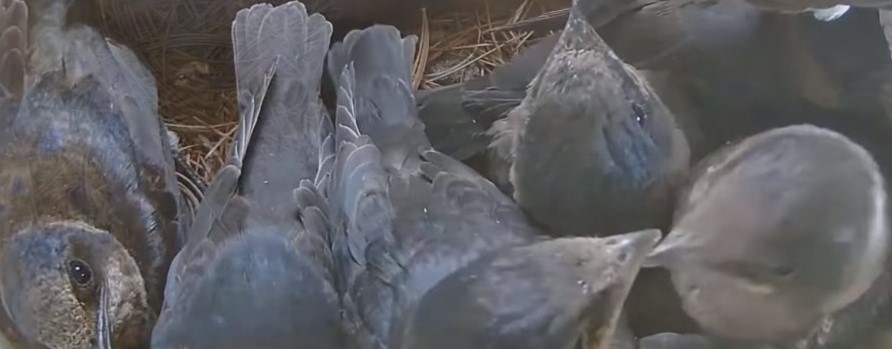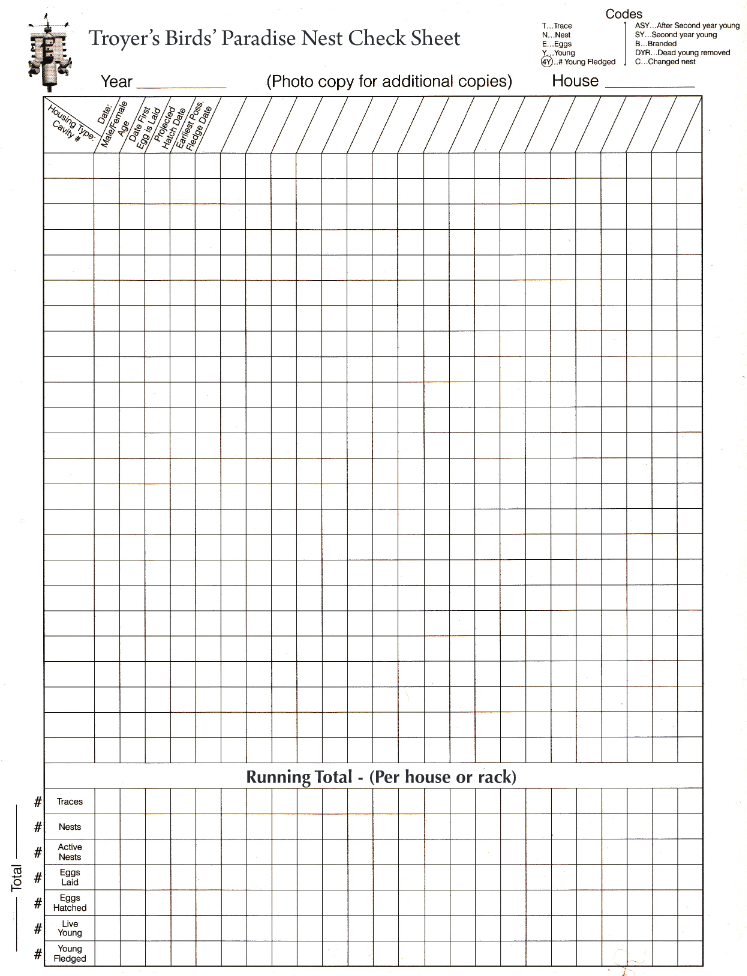Purple Martin Nest Checks
A Novice Approach to Purple Martin Nest Checks
A nest check guide will provide you with an approach to monitor your colony.
Some Common Myths About Nest Checks
- No need to check, martins have been living in housing at this colony site for years
- Martins will abandon the nest if you lower the house to check things out
- Martins can smell, therefore they can tell that you have touched the nest and will not return
Why Do A Nest Check?
- To see what’s going on in each compartment
- To record when nest building begins, eggs are laid, or babies will fledge.
- To see if there are any predators like snakes, squirrels or owls inside the cavities
- To see if there are any other insects: ants, beetles, wasps in the house
Tools for the Nest Check (Some suggestions)
- Clipboard with paper and pencil
- Smart Phone
- Tablet
- Tape recorder
- Digital camera
- Video Camera
- Data form
- Prognosticator and PUMA ID Charts (available from the PMCA)
- Small auto mirror to view eggs
- Cups and strings for plugging holes
- Disposable gloves/dust mask/baseball cap to keep insects out of your hair
- Nesting material
- An extra empty gourd/spare nest tray just in case
- Extra housing parts
- Small flashlight
- Clothespins for reinforcing Trio door clips
- Spare netting for snake prevention
- Long retractable pole with an attached retractable cup to return young to nest compartment
- Large plastic container to carry contents
How to Proceed
- What to look for
- When to check
- How long do you keep the housing down
- Setting up a schedule
- Post nest check procedure
- Special occasion nest checks
What to Look For
Purple martins usually spend much of the morning hours around the house doing their domestic chores like choosing their compartment, attracting a mate, mate guarding, defending a compartment (s), nest building, gathering mud, nest material, leaves, laying eggs, feeding young, preening, or feeding on their bed and breakfast tray if one is provided. Any one of these activities will give you an idea of their progress. ie: Leaves in a nest are a sign that egg-laying will begin soon. This might be a good time to start your regular nest checks.

When to Check
I recommend that nest checks be done after the morning activities have been suspended and the weather has warmed up and most of the martins have left to go out feeding. In the early martin season, it’s not uncommon for the entire colony to leave and this is the best time to check nest progress. Use your tablet, voice recorder, pen and paper, and record what you see happening in the house. The Nest Watch data sheet that the PMCA allows for various observations but often landlords will keep a diary of their own colony. Electronic data forms are also readily available on the internet. It is recommended that you do a nest check minimally once a week and more often as the season unfolds. THE PMCA RECOMMENDS EVERY 4 TO 5 DAYS TO DETERMINE WHEN THE FIRST EGG IS LAID AND 5 TO 7 THEREAFTER. If the weather is too cool or too warm or the martins are stressed will also influence whether the housing should be lowered.
After the eggs are laid, it is recommended that the housing be lowered cautiously so that the eggs are not abruptly rolled out of their nests by martins exiting their compartments. Sometimes just speaking loudly, or tapping on a compartment before opening the door will avoid a martin flushing into your face. Brooding hens will often sit tight and observe you as you do your nest check. Sometimes, this is the best time to see if a martin is banded or has suffered an injury by overzealous males.
How Long To Keep the Housing Down
There is no exact number of minutes that housing should be lowered. Use Common Sense when doing a nest check. If you only have 6 pairs to monitor, there is no reason to keep the housing down for twenty minutes. THE AMOUNT OF TIME A HOUSE IS DOWN WILL BE DETERMINED BY THE SIZE OF THE COLONY. If your martins have not begun to lay, you can quickly determine how many nests you have and at what stage it is developed. As your martin season continues, egg-laying will begin usually at sunrise so it is important to leave the housing alone.
You will see that after the first egg is laid, an egg will be laid each day until the nest clutch is completed. 5-7 days on average. After that time the hen will be brooding her eggs for a precise number of days until they hatch. If the first egg was laid on June 5th, (a clutch of 5 eggs), the chicks will begin hatching on June 21. How do I know? I use a Purple Martin Prognosticator/Baby photo prints. Always determine the first egg-laying date.
SOMETIMES TWO OR THREE NEST CHECKS MAY BE MADE AT DIFFERENT TIMES OF THE DAY DIVIDING THE TIME AMONG THE NUMBER OF HOUSES, AND GOURDS THAT YOU HAVE INSTALLED. Leaving the housing down for more than 20 minutes only aggravates the martins and causes them to be alarmed. I’ve seen Martins abandon a compartment when the landlord has been too scrupulous and kept the housing down too long. Sub-adult martins are often more easily frightened off than adult martins when it comes to this abuse.
Sometimes you will have to do three or more nest checks to determine each of the colony’s inhabitants’ first egg-laying day. Hatching days will also be determined by weather conditions and may vary by 5-10 days. Eggs usually hatch in fifteen days and chicks normally fledge between 28 to 32 days. Do not check compartments that contain nestlings that you know are 22 days or older. You can plug these holes with a Styrofoam cup plug with a string and remove them once the housing is raised. Wait about ten minutes before removing the plugs.
Set up a Schedule
Our daily chores and family commitments often interfere with Nest Checks, so I often recommend taking out your Nest Datasheet and determining each day that you will conduct a nest check. You will be on schedule, and any missed day can be quickly made up the day after.
Post Nest Check Procedure
- Ensure that all door plugs are removed
- Install the safety pin on your pole
- Attach the predator/snake guard
- Lock your system to maintain site security
- Finally, ensure that all owl guards, if installed have been redeployed properly.
- Do a walk around to ensure that no chicks have decided to fly out after you have completed your nest check
- Step back and observe as the martins return to their regular daily routines
Special Occasion Nest Checks (When you should check!)
- When you notice martin feathers or another accipiter (Hawk) feathers around the colony
- When your house doors are ajar or the martins can’t enter their compartment
- When a chick is out on the porch and can’t get back or you see the housing crawling with insects
- When you find broken eggs or martin’s body parts on the ground
- When a competitive species are lurking about or going in and out: sparrow, starling, tree swallow, bluebird
- After inclement weather: a cool spell, heavy rain, or very windy conditions
The PMCA Market Place has the Prognosticator and the Baby Photo Laminated Plates for sale on their website. The Martin Watch data forms are also free for download. Check out the PMCA article on how to use a prognosticator as well as baby photo laminated sheets.
Further guide information about Nest Checks can be found at the PMCA Site or by using the Troyer check list.

Tending to Sick, Injured, or Orphaned Purple Martins
The PMCA has provided some written suggestions to follow if you find a grounded Purple Martin baby or adult. The PDF is posted for your convenience.


